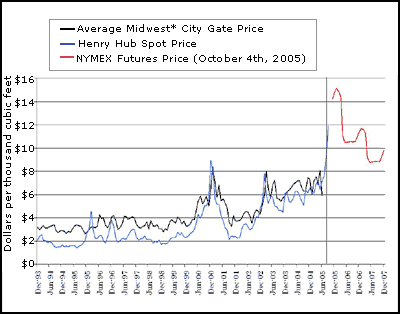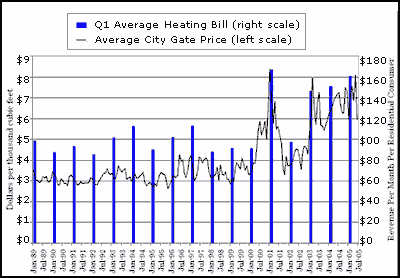Hurricane Impacts and Energy Prices
As the water recedes and the human toll accumulates in the hurricane-impacted Coastal regions, discussion has turned to the economic impact. Many areas and communities immediately surrounding the Gulf Coast are experiencing increased business and real estate activity as evacuees try to refocus their lives and homes, even as local governments and charitable organizations struggle mightily to lend assistance and resettle evacuees. Midwest economic activity will pick up in several ways during the coming months, but these will likely be outweighed by rising energy prices—-especially for natural gas, which is used to heat Midwest homes.
Hurricanes and other natural disasters are often accompanied by interruptions in economic activity and are followed by upswings and regional diversions in economic activity. Parts of the Midwest have felt the disruption through our ties to the Gulf Coast economy. Shipment delays and sharp price spikes for petroleum-based chemicals have slowed production for Midwest manufacturers of tires and furniture. Midwest grain shipments down the Mississippi were delayed and diverted by Hurricane Katrina, though they have now largely resumed or been diverted in other directions.
In other ways, the hurricane impacts are boosting Midwest economic activity. Some evacuees have taken refuge in Midwest communities, and now reside with relatives or in donated facilities. In response, government operations such as schools must bolster their payrolls. The added spending of the new families will be an infusion into Midwest income and spending streams.
As for “export” industries, mobile and trailer home construction in northern Indiana and other areas of the Midwest have been called into hot demand by FEMA. Emergency workers, evacuees, and homeowners who are in the process of rebuilding their properties must have housing—-at least temporarily. And the region’s manufacturers of earth-moving and construction equipment, such as Caterpillar, and makers of other rebuilding tools, such as electric equipment and generators, will experience some added sales. And of course, flood-damaged autos and homes will require such Midwest staples as motor vehicles and home appliances. Chicago also has gained several upcoming conventions dropped from the New Orleans calendar.
But rising natural gas prices loom large as the Midwest approaches the home-heating season, due to supply disruptions from the Gulf. Other cold-weather regions, such as New England, burn home heating oil. The Midwest enjoyed low home heating bills from the late 1980s to the mid-1990s when natural gas prices were very low and gas utilities were paying about $2 to $3 per thousand cubic feet of natural gas (mcf). But in recent years, natural gas prices have been rising because of higher demand for gas from electricity utilities and from its use as a substitute for petroleum.
In the regional newsletter of the Federal Reserve Bank of Dallas, veteran energy economist Steve Brown investigates the relationship between petroleum prices and natural gas prices (Southwest Economy July/August 2005). Although the two fuels are no longer common substitutes in electric generation, Steve finds that the two fuel prices continue to move in tandem—-with two exceptions. Natural gas prices are higher in the winter, and they also depend on how much is stored during the summer for use in the winter. In the Midwest, natural gas is stored in the summer in underground aquifers, salt caverns, and abandoned gas wells. According to Brown, if 10 percent less gas is stored now than the average in the previous five years, natural gas price prices will go up 23 cents nationally.
What can cause these shortfalls in stored volumes? Winter cold snaps for one, whereby vendors drain their stored reserves to meet demand. Cold snaps contributed to price spikes during the winter of 2000-2001 and 2002-2003 when the spot price approached $10 and $12 per mcf. Abnormally hot weather during the summer can also contribute to a shortfall. The hot spell in the Midwest this past summer increased natural gas prices and slowed storage as some electric power generators fired up on natural gas to feed air conditioning units. And finally, of course, supply interruptions such as those from Hurricanes Katrina and Rita can slow the pace of storage. This is a particular problem for the Midwest since most of our natural gas supplies come from the Gulf Coast area.
How much will natural gas prices rise this winter as a result of the Gulf hurricanes? Not quite as much as current rises in spot market prices and contract prices for future delivery suggest. During the heating season, gas distributors blend new spot market purchases with the natural gas already purchased and stored or pre-contracted. Likewise, the delivered price to homes reflects a price blend of the stored gas, as well as gas purchased under long-term contract, with augmented or spot market purchases. A colder-than-normal winter, or low volumes of stored or pre-contracted gas, would tend to tilt the blend toward higher-priced spot market purchases, which could deliver a ruder heating bill shock to Midwest households.
The figure below shows that reported spot prices do follow the acquisition, or “city gate,” prices that gas distribution utilities pay for natural gas. This past summer, and intermittently since 2000, the measure of spot price was running roughly double that of the 1990s. Due to the current supply disruptions, the prices for delivery under futures prices on the NYMEX were running double that of this past summer at over $14 for December 2005 and January 2006 delivery, though falling in the years thereafter.
1. "Henry Hub Spot Price, Midwest City Gate Price, and NYMEX Futures Price for natural gas

Rising gas city gate prices push up home heating bills, though less than proportionately because home heating bills also include distribution and delivery costs, which are more stable. The figure below compares past city gate prices in the Midwest to home heating bills. Heating bills rise only moderately less steeply than city gate prices. Natural gas expenses per household in the Midwest for the November–March heating season averaged $445 from 1996-97 through the 1999-2000, but had climbed to an estimated $732 last winter (which was a mild winter). In its recent “Short Term Energy Outlook,” published just after the Katrina and before the Rita disruptions, the U.S. Department of Energy estimated that home heating bills in the broader Midwest, under normal heating circumstances, will be 71 percent above last year.
2. Midwest natural gas prices, monthly 1982-2003 (weighted by consumption)

The U.S. Department of Energy (DOE) does not include any measurement of uncertainty in its model forecasts, so these estimates should be taken as nothing more than a rough guess … not only because of the vagaries of the weather, but because little is known about the amount of gas stored at Midwest utilities or purchased under long-term contracts for later delivery. The extent of damage to production of natural gas in the Gulf region is only now being assessed, but early indications are that Rita was less damaging than the initial assessment. Until we know how long it will take to restore lost production, and its effects on spot price, winter heating costs remain a big question mark.
In any event, despite some possible benefits from the hurricanes for the regional economy, most Midwest households will wish they had never heard the names Katrina and Rita as they feel the frosts and pull out their checkbooks to pay the bills this winter. In our 2001 Chicago Fed Letter, Thomas Klier and I found that the cold weather snap took a 1.74 percent bite out of Midwest disposable income (versus 1.01 percent for the U.S.) during the winter of 2000-01, up from 1.05 percent the previous winter (Chicago Fed Letter). And gasoline prices, though up sharply that year, averaged $1.40 in the Midwest in 2001. They’ve averaged $2.19 so far this year in the Midwest, with a 40 cent jump after Hurricane Katrina. Who said that hurricanes could only damage coastal regions?








